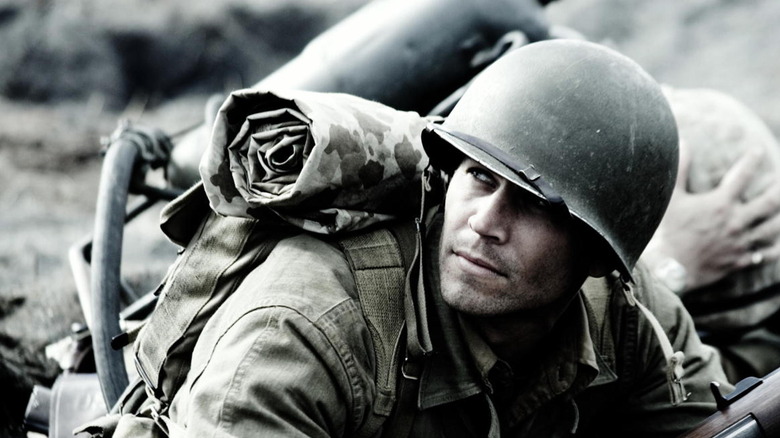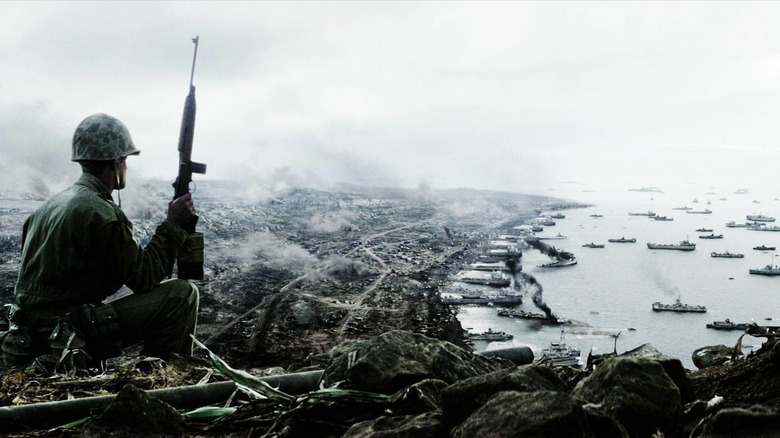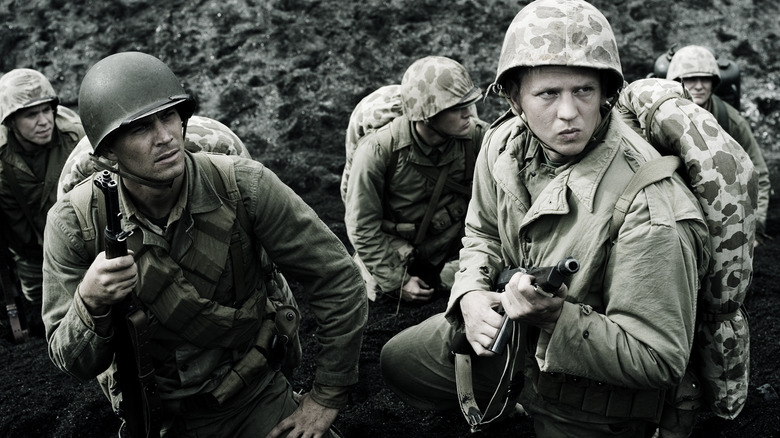The Idea That Guided Clint Eastwood Through Filming Flags Of Our Fathers
The tone of Clint Eastwood's 2006 war film "Flags of Our Fathers" might be surprising. "Flags of Our Fathers" is a film extrapolated from the celebrated 1945 Joe Rosenthal photograph titled "Raising the Flag on Iwo Jima," taken at the eponymous battle, and featuring a group of American soldiers hoisting their nation's flag just after the carnage. The photograph also served as the model for the Marine Corps War Memorial, sculpted in 1954 and located in Arlington, Virginia. The screenplay was an adaptation of a book by James Bradley and Ron Powers, whose fathers are featured in the photograph, hence the title.
Ever since the days of "Twelve O'Clock High" in 1949, whenever American filmmakers make movies about American soldiers, they tend to be romanticized stories of survival and victory. Given the subject matter of "Flags of Our Fathers," one might presume that it, too, stands as a tale of honor and tenacity. Weirdly, however, "Flags of Our Fathers" is aggressively downbeat. Eastwood directed cinematographer Tom Stern to wash out a lot of the film's color, leaving everything looking muddy, drab, and unappealing. The action is not thrilling or dynamic in the way cinematic combat might be in an action picture, and there are many moments of dour reflection and quiet sadness. Any semblance of jingoistic patriotism lingers far, far in the background.
"Fathers" may not carry the antiwar heft of, say, "Platoon" — it's not nearly so dour and cynical — but it certainly undercuts any pro-war sentiment with a tone of inescapable melancholy. It turns out this was a conscious decision on Eastwood's part. In a 2007 interview with Terry Gross on the NPR show "Fresh Air," Eastwood explained his filmmaking approach and how it was based on his real-life encounters with actual veterans.
Conversations with the survivors
Terry Gross asked Clint Eastwood if he talked to veterans of the actual Battle of Iwo Jima. Survivors were scant, as, according to a report on Military.com, some 27,000 Americans and 18,000 Japanese soldiers died. Eastwood discussed the film's central image, the Rosenthal photo, but recalls more sharply an unspoken trauma. Eastwood doesn't speak too clearly, but he clearly seemed moved by the soldiers' lack of nostalgia as one might encounter in the movies.
"Well, yeah, there is. There's one image that is kind of common, is that most of them that were in combat there, they just never really spoke about it too much. They would get together and maybe have a Marine Corps celebrations or Marine Corps organizations, but they wouldn't really get into the ... they didn't ... there's not the 'gung-ho-ness' that you'd think there would be. There was just ... It was a tremendous battle."
Movies in the 1940s did indeed address post-traumatic stress, as in the excellent "The Best Years of Our Lives." While "Flags of Our Fathers" isn't about the psychological damage suffered by the soldiers, it certainly informs the film at large. Eastwood himself would eventually make a film about post-traumatic stress with his 2014 film "American Sniper." That film, however, weirdly argues that post-traumatic stress can be merely overcome with enough work and tenacity, overlooking the lasting effects that cannot be shed.
Eastwood acknowledged that, pointing out that the Battle was meant to be simple ... but wasn't:
"It was intended to be a three or four-day affair, lasted over a month. And they were pinned down a good portion of the way. When you see an awful lot of your friends are wounded and killed, it's not something you forget easily."
Clint Eastwood and war
Clint Eastwood's relationship with war has, throughout his decades-long career, remained somewhat ambiguous. As an actor, he starred in cynical war films like "Kelly's Heroes," and even whimsical wartime comedies like "Frances in the Navy." Throughout the 1970s, he spent most of his time performing in crime dramas and Westerns. Notably, his Western "The Good, The Bad and the Ugly" was set around the Civil War, presented by director Sergio Leone as a backdrop of a world in disarray. As a director, Eastwood began to skew more serious, as when he made "Heartbreak Ridge" in 1986. His diptych of "Flags of Our Fathers" and its 2006 follow-up "Letters from Iwo Jima" (the same battle, as seen from the perspective of the Japanese soldiers) seem to be wounded and bitter about the war.
With "American Sniper" and "The 15:17 to Paris," Eastwood began actively venerating soldiers, in the latter case, casting them in the movie of their lives. Politically speaking, Eastwood was, for many years, openly conservative, and served as the mayor of Carmel, CA from 1986 to 1988. In 2008, however, Eastwood declared himself to be more Libertarian, claiming that things had gotten too complicated to be on one extreme end of the political spectrum or another. "It's a zoo out there," he said.
"Flags of Our Fathers" came during the George W. Bush administration while America was involved in multiple wars. Perhaps the sadness Eastwood put into the film stemmed from an increasing disillusionment with jingoistic language. One cannot look at the real Battle of Iwo Jima too closely, after all, without seeing sadness and death.


